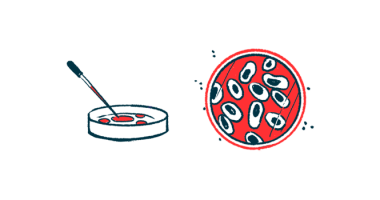TANGO2 Heme Transport Protein May Be Therapy Target in Porphyria
Scientists: TANGO2 ensures heme won't build to toxic levels in cells

Heme, a molecule crucial for several biological processes, is transported from sites of production or storage for use in cells with the help of a protein called TANGO2, a team of researchers have discovered.
Because TANGO2 ensures heme is available for use — and that it does not accumulate to toxic levels inside production sites within cells — the team say it may serve as a new treatment target for diseases, such as porphyria, that are associated with heme dysregulation.
“The discovery of a new protein that ensures heme is made bio-available may serve as a new therapeutic target in many disease contexts,” stated a university press release from Georgia Tech researchers who were involved in the study.
That study, “RG-9 homologues regulate haem trafficking from haem-enriched compartments,” was published in the journal Nature.
A potential therapy target
Porphyria is a group of genetic conditions caused by disruptions in heme production. Such disruptions lead to the toxic buildup of heme precursors in different tissues and organs, most often in the kidneys, liver, and skin.
Heme is a ring-shaped, iron-containing molecule that plays a key role in several processes in the body. Among them are oxygen transport, the activity of mitochondria, which serve as a cell’s powerhouses, antioxidant responses, and signal transduction.
However, free heme is highly toxic, and within cells it has to be transported by special proteins called heme chaperones.
While the process of heme production and breakdown is well-established, how it is transported from its production sites and storage for use in cells remains unclear.
Given the toxic nature of heme, understanding heme transport within cells may shed light on processes associated with heme dysregulation, such as those in porphyria. It also may support the development of new therapies.
To learn more, researchers in the U.S. and China began by studying C. elegans, a tiny worm widely used as a disease model because many of its genes have functional human counterparts.
The model also is ideal for investigating heme transport because it relies solely on dietary heme, which requires heme to be absorbed into the intestines and transported to various tissues.
Gene activity analyses of the animals’ intestines showed that the activity of a previously uncharacterized gene, called hrg-9, was elevated more than 30 times when exposed to low heme versus high heme.
Hrg-9 was activated predominantly in the worm’s intestines throughout all stages of development.
“These results demonstrate that hrg-9 is a [heme-responsive] gene specifically induced by [heme] deficiency in the worm intestine,” the researchers wrote.
Suppressing hrg-9 or its related gene hrg-10 in worms resulted in a heme deficiency response, and in heme accumulation in lysosome-related organelles, or cell type-specific membrane-bound structures that “have been demonstrated to be the [heme] storage site in worms,” the team wrote.
Further testing revealed that the observed heme accumulation was associated with a deficient transport of the molecule out of lysosome-related organelles.
In agreement, deleting tango2 — the hrg-9 gene equivalent — in lab-grown yeast and human kidney cells resulted in an accumulation of heme inside mitochondria, heme’s production site.
In addition, while Tango2 deficiency in lab-grown mouse cells reduced heme production overall, it increased heme levels within mitochondria, further suggesting that TANGO2, the protein coded by the Tango2 gene, “may facilitate [heme] trafficking out of mitochondria,” the researchers wrote.
TANGO2 deficiency also was associated with an impaired mitochondrial function, “a defect that was probably caused by increased mitochondrial [heme],” the team wrote.
Treatment with TANGO2, either from yeast or humans, promoted the transfer of heme from mitochondria to myoglobin, a protein that binds heme to store and release oxygen in cells. This confirmed TANGO2’s function in transporting heme out of mitochondria, the team noted — a process that did not require mitochondrial membrane proteins.
Removal of a TANGO2’s protein section that was identical between humans and yeast, suggesting functional importance, abolished the protein’s ability to transfer heme. Consistently, TANGO2 from humans, mice, or yeast, was able to bind heme directly, indicating a role as a so-called chaperone protein for heme.
Still, although TANGO2 binds heme, it does so relatively weakly, “indicating that it acquires [heme] only from [heme]-enriched cellular compartments,” the researchers wrote.
Notably, mutations in the human TANGO2 gene are known to cause a hereditary disorder marked by developmental delays and regression, poor coordination, irregular heartbeats and metabolic problems.
Deletion of TANGO2 in zebrafish recapitulated many of the same features, including brain and muscle defects, and irregular heartbeats. Eventually, all mutant zebrafish died.
“Since mutations in the TANGO2 gene cause a hereditary disease characterized by developmental delays and defects in metabolism, our finding that TANGO2 plays a role in heme homeostasis suggests that the development of heme-centered therapies may treat such diseases,” said Amit Reddi, PhD, one of the study’s senior authors and an associate professor at Georgia Tech.







